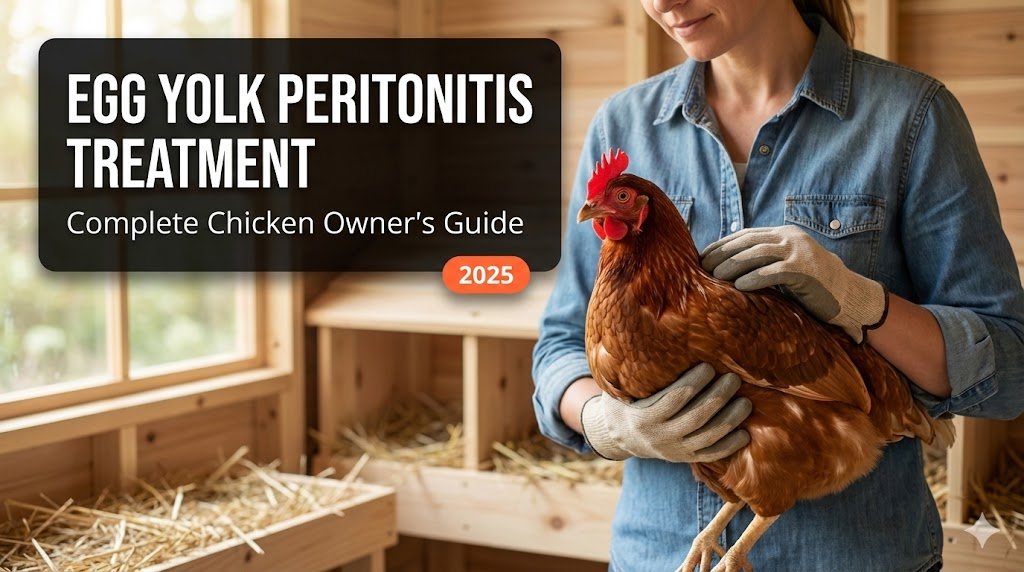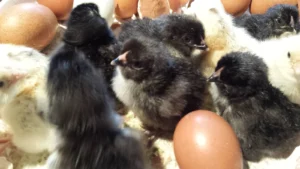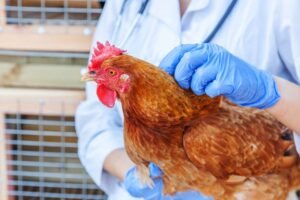Medical Disclaimer: This article provides educational information only and should not be considered professional veterinary advice. Diagnosis and treatment of egg yolk peritonitis should only be performed by licensed veterinarians. The author and publisher disclaim any liability for actions taken based on this information without veterinary consultation.
Sensitivity Note: This guide contains detailed descriptions of poultry illness symptoms and internal anatomy which may be disturbing to some readers.
When your favorite hen starts walking like a penguin with a swollen belly and stops laying eggs, you might be witnessing egg yolk peritonitis – one of the most common reproductive disorders in backyard chickens. That moment hits hard – fear for your hen, worry about the rest of the flock, and uncertainty about what comes next.
Veterinary research from VCA Animal Hospitals indicates this condition occurs when egg yolk enters the abdominal cavity instead of traveling through the oviduct as it should. While egg yolk peritonitis treatment can be challenging, understanding the symptoms early and knowing your options can make the difference between life and death for your hen.
You’ll find clear answers here, from spotting that first warning sign through managing recovery, so you can make the best decisions for your flock.
What Is Egg Yolk Peritonitis? (Understanding the Condition)
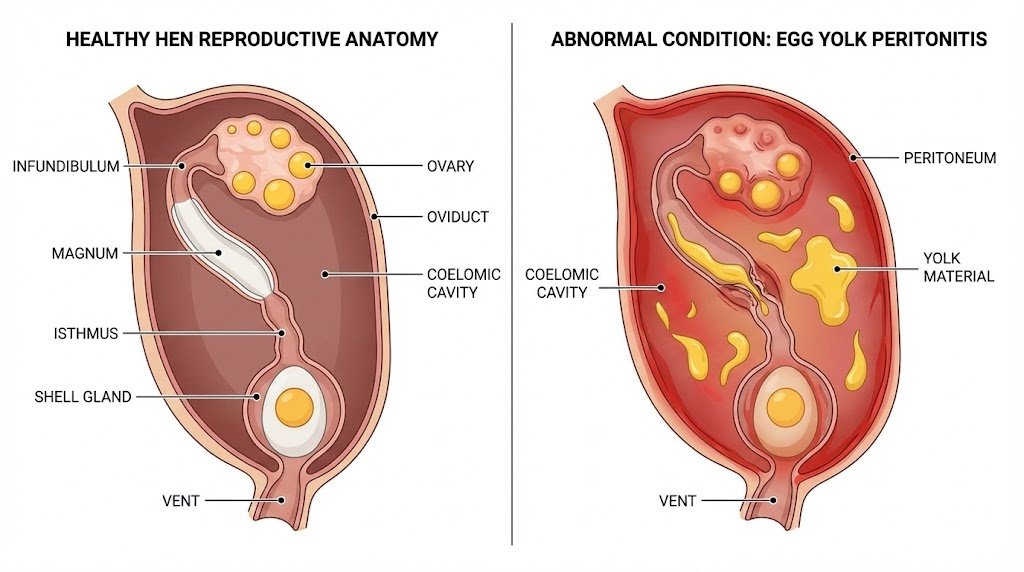
To understand peritonitis, we first have to look at how a healthy hen lays an egg. Think of the hen’s reproductive system as a factory line. The ovary releases a yolk (the yellow part), which is supposed to catch a ride into the oviduct (or salpinx). The oviduct is like a tunnel that guides the egg safely out of the body, adding the white and the shell along the way.
However, things can go wrong. Egg yolk peritonitis happens when that yolk misses the entrance to the tunnel or is pushed back out of it. Instead of becoming an egg, the yolk falls into the hen’s coelomic cavity (the avian equivalent of the abdomen).
Because egg yolk is rich in nutrients, it is unfortunately the perfect food for bacteria. When that yolk sits in the coelomic cavity, it causes severe inflammation of the lining, known as the peritoneum. This inflammation is called coelomitis or peritonitis. Often, this condition appears alongside salpingitis (inflammation of the oviduct), creating a complex reproductive crisis. Understanding the mechanics of this peritoneal inflammation is crucial because successful egg yolk peritonitis treatment depends on realizing that the coelomic cavity is filling with bacterial fuel (yolk) that cannot be easily flushed out.
Poultry health specialists at the Merck Veterinary Manual state that egg yolk peritonitis describes inflammation of the serosal surfaces within the hen’s coelom in response to yolk material deposited into the body cavity. Research from VCA Animal Hospitals explains that normally, the developing egg passes from the ovary into the oviduct and out through the vent as a fully formed egg, but with peritonitis, yolk material enters the coelomic cavity instead.
Is this the same as internal laying? Yes and no. Poultry DVM clarifies that internal laying is the event (the yolk going inside), while egg yolk peritonitis is the result (the infection and inflammation caused by that yolk).
How Do You Know If Your Chicken Has Egg Peritonitis? (Recognizing the Symptoms)
Catching this condition early is vital. Because chickens are prey animals, they are experts at hiding illness until they are very sick.
What Is One of the First Signs of Peritonitis?
Here’s what many owners miss: often, the very first clue isn’t physical – it’s behavioral. You might notice your hen acting “off.” She might isolate herself from the flock or stop running for treats. A major red flag is a change in laying habits. If a high-production breed like a Rhode Island Red or Leghorn suddenly stops laying without molting or being broody, pay close attention.
Classic Symptoms of Egg Yolk Peritonitis

If the condition progresses, you will see more obvious signs.
Behavioral Changes:
- Lethargy: She stands around with her eyes closed or head pulled in. If you notice your hen acting lethargic or withdrawn, this behavior can signal various health issues. Poultry DVM notes that affected hens often exhibit depression and a lack of appetite.
- Nesting behavior: She might spend hours in the nesting box but never produce an egg. This is often mistaken for broodiness, but unlike a broody hen, she won’t fiercely protect the nest; she is just there because she feels bad.
- Reduced foraging: She stops scratching and pecking.
Physical Signs:
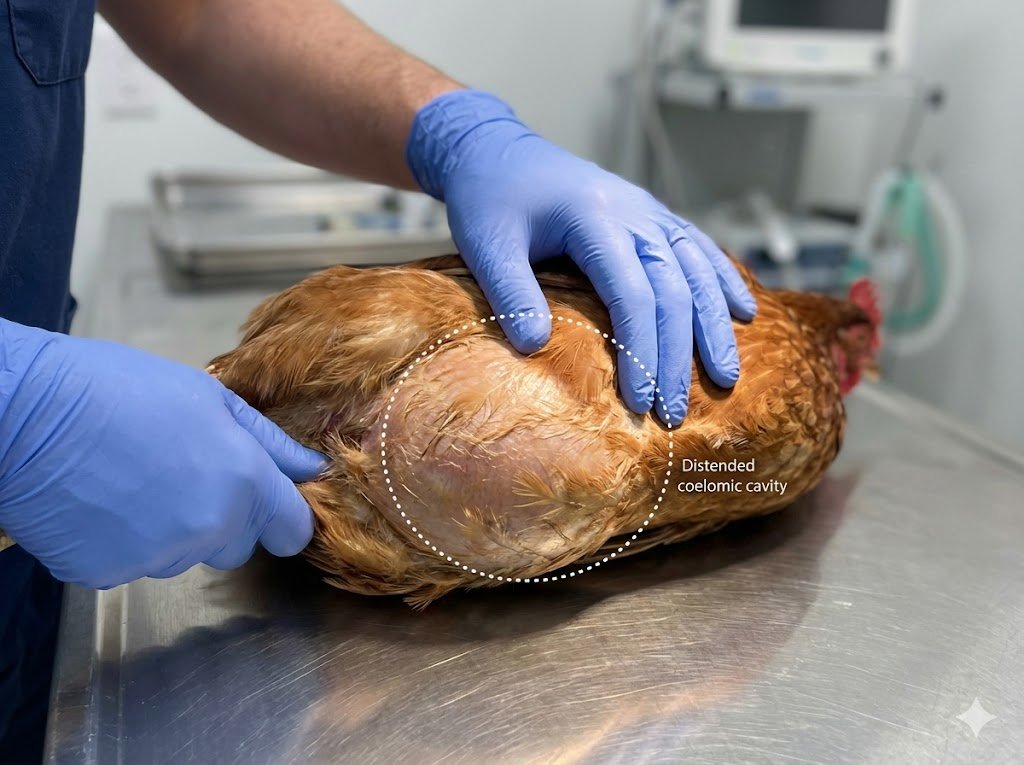
- Penguin Stance: This is the hallmark sign. The British Hen Welfare Trust describes this as a wide-legged stance where the hen resembles a penguin, which explains the characteristic “waddle.” She does this to relieve the pressure on her lungs caused by the fluid in her abdomen.
- Swollen Abdomen: If you gently feel her belly (the area between the legs and the vent), it may feel tight, hot, and squishy, like a water balloon. This is fluid accumulation, also known as ascites in chickens.
- Labored Breathing: You may see her tail bobbing up and down as she breathes, or she might be open-mouth breathing.
- Red Comb: Surprisingly, her comb might stay vibrant red even though she is sick, which can be confusing.
Changes in Droppings: Identifying “Egg Yolk Peritonitis Poop”
One distinctive sign that brings many owners to search “egg yolk peritonitis poop” is the appearance of unusual droppings. When a hen has this condition, you may notice droppings that contain yellow or orange material that looks like cooked egg yolk or scrambled eggs. This happens because some yolk material can pass through the digestive system.
The droppings may also appear watery or contain what looks like albumen (egg white material). Normal chicken droppings have a dark portion (feces) and a white cap (urates), but with peritonitis, the distinctive yellow yolk material is the warning sign.
Visual Identification: What Does Egg Yolk Peritonitis Look Like?
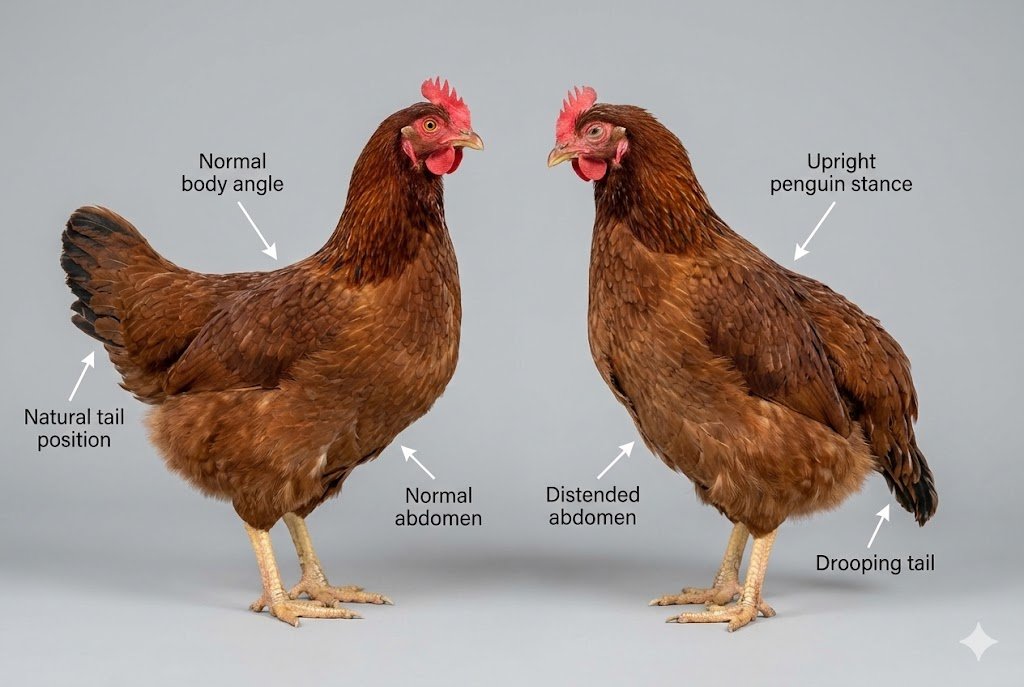
Many chicken owners search for “egg yolk peritonitis pictures” to compare what they are seeing with their hen. While photos are helpful, understanding the visual signs can help you identify the condition even without images.
The Penguin Stance (Most Distinctive):
From the side, an affected hen looks like she is standing at attention. Her body forms an unusually vertical angle – almost 60-70 degrees upright instead of the normal 30-40 degree angle of a healthy chicken. Her tail points down toward the ground, her neck is scrunched into her shoulders, and her head pulls back. This posture happens because the fluid in her belly makes standing normally uncomfortable.
Abdominal Swelling: Looking at the hen from behind or underneath, her abdomen appears noticeably distended. The area between her legs and vent looks swollen and rounded, sometimes extending past her body width. In severe cases, the skin may appear thin and stretched, and you might notice missing feathers in the abdominal area due to the constant pressure.
Keel Bone Prominence: Despite the large belly, the keel bone (breastbone) juts out prominently because the hen has lost muscle mass from not eating and the chronic illness. If you gently run your hand along her chest, the bone feels sharp and pronounced.
Comb Appearance: One thing that surprises people is that the comb often stays vibrant red, which can be confusing. Specialists at the British Hen Welfare Trust report that while most sick chickens have pale combs, the bright red comb in egg yolk peritonitis indicates the hen’s body thinks she is still in laying condition.
Droppings: “Egg yolk peritonitis poop” is a common search term because the droppings look distinctive. You might see yellowish, yolk-colored droppings or droppings with an unusual texture resembling scrambled eggs. This happens when yolk material passes through the digestive system. You might also observe unusual egg-laying behavior and egg problems that often precede the illness.
Comparison Photos (If Available):
If your hen matches these visual descriptions, especially the penguin stance and swollen abdomen, schedule a veterinary appointment immediately. While we cannot include graphic post-mortem images in this guide, your veterinarian can show you reference photos during your consultation to help you understand what they’re seeing internally if your hen requires diagnostic imaging or unfortunately passes away.
What Causes Egg Yolk Peritonitis in Backyard Chickens?
If you’re sitting here asking yourself “Why her? What did I do wrong?” I want you to know that egg yolk peritonitis happens even to the best chicken keepers. It is usually a combination of factors, and rarely just one mistake.
Underlying Reproductive Problems
Sometimes the oviduct itself is damaged. Conditions like salpingitis (inflammation of the oviduct) are primary triggers. Salpingitis can cause the oviduct walls to swell, blocking the egg’s path. Other issues like ovarian cysts or ovarian tumors can also block the path. If the tunnel is blocked due to salpingitis or tumors, the yolk has nowhere else to go but inside the coelomic cavity. Impacted oviducts or twisting of the oviduct can also be triggers. Soft-shelled or shell-less eggs often indicate reproductive system problems that can precede peritonitis.
Bacterial Involvement
The yolk causes inflammation, but bacteria cause the infection that kills. Rural Veterinary Outreach notes that bacterial organisms most commonly involved are Escherichia coli (E. coli) and Enterococcus. These bacteria often migrate from the intestinal tract through the cloaca and up into the reproductive tract, causing ascending salpingitis and peritonitis. Hens with peritonitis are more susceptible to bacterial infections in chickens which require prompt veterinary treatment with appropriate antibiotics.
Management-Related Causes
We as chicken keepers sometimes accidentally contribute to the risk.
- Understanding EODES (Erratic Oviposition and Defective Egg Syndrome): According to the Merck Veterinary Manual, overfeeding broiler breeder hens during sexual maturation can cause EODES – erratic oviposition and defective egg syndrome. This condition results in multiple large ovarian follicles, leading to double-yolked eggs, oviduct prolapse, and internal laying that often progresses to egg yolk peritonitis. EODES is prevented by avoiding light stimulation of underweight pullets too early and maintaining proper body weight and uniformity.
- Overfeeding: General obesity is a huge risk factor distinct from EODES. Fat hens often have trouble laying due to crowded body cavities. Research in the Sokoto Journal of Veterinary Sciences highlights how poor management factors contribute to clinical presentation and severity.
- Artificial Lighting: Keeping lights on all winter forces hens to lay year-round without a break, stressing their reproductive systems. A review published in JSciMed Central notes that egg peritonitis is more common in flocks exposed to too much artificial light at a young age. Interestingly, some poultry veterinarians report higher rates of egg peritonitis in northern climates during late spring when artificial lighting is discontinued and day length increases rapidly, potentially shocking the hen’s reproductive system. However, formal studies on this seasonal pattern are limited.
- Stress: Fright or stress during ovulation can cause the yolk to “miss” the oviduct.
The Role of Viral Diseases
Certain viral infections can damage the reproductive tract, setting the stage for peritonitis. According to VCA Animal Hospitals, diseases like Marek’s disease virus and avian leukosis virus may affect the reproductive tract directly or cause immune deficiency that allows bacterial infection. If egg yolk peritonitis is caused by these viral diseases, the prognosis is usually poor, even with aggressive treatment. This is one reason why vaccinating chicks against Marek’s disease when possible is important – it prevents the reproductive complications that can lead to peritonitis later in life.
Research from Merck Veterinary Manual indicates that antimicrobial treatment is often ineffective once bacterial infection has established, emphasizing the importance of prevention.
How Do You Diagnose Egg Peritonitis? (Veterinary Diagnosis)
If you suspect peritonitis, a visit to an avian veterinarian is the best course of action. While it costs money, getting a clear answer helps you decide between treatment and humane euthanasia.
Many owners ask “how do you diagnose egg peritonitis at home?” The answer is: you can’t definitively diagnose it without veterinary examination. While you can recognize symptoms that strongly suggest peritonitis, only veterinary diagnostic tests can confirm the presence of yolk material and bacterial infection in the coelomic cavity.
Physical Examination
The vet will gently palpate (feel) the abdomen to check for fluid, masses, or trapped eggs. They will assess her weight and listen to her breathing to see if the fluid is compressing her air sacs.
Diagnostic Tests
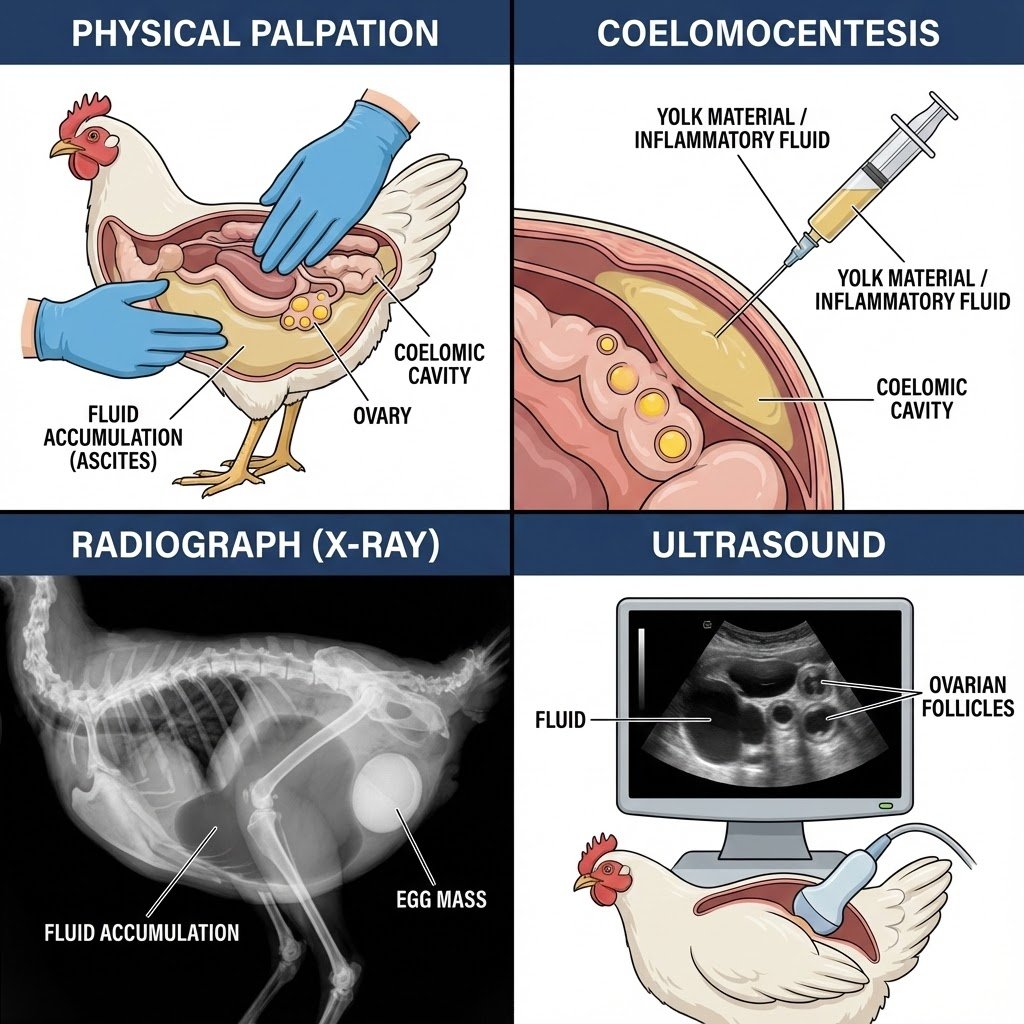
To confirm the diagnosis, your vet might suggest:
- Complete Blood Count (CBC): This blood test checks white blood cell levels. Veterinary protocols from VCA Animal Hospitals suggest that a Complete Blood Count (CBC) typically shows elevated white blood cells (leukocytosis), indicating inflammation or infection.
- Coelomocentesis (Fluid Analysis): The vet inserts a small needle into the belly to draw out fluid. If the fluid looks like yellow yolk or pus, it confirms the diagnosis. The Merck Veterinary Manual recommends coelomocentesis to collect samples for cytology and bacterial culture. Cytology involves looking at the cells under a microscope to identify bacteria and inflammatory cells, helping determine which antibiotics will be most effective.
- Radiographs (X-rays): X-rays can show “shelled” eggs floating in the belly or masses that might be tumors. Studies published in the Scientific Research Publishing journal confirm that ventro-dorsal X-rays are effective in identifying soft tissue inflammation in these cases.
- Ultrasound: This gives a “live” look at the fluid and the ovary condition. Recent research in the International Journal of Veterinary Sciences highlights ultrasound as a critical tool for guiding treatment protocols.
Diagnostic Tests Comparison
| Test | Purpose | What It Reveals | Typical Cost (2025 US) |
|---|---|---|---|
| Physical Palpation | Initial assessment | Fluid presence, pain response | Included in exam ($50-$100) |
| Complete Blood Count (CBC) | Detect infection | Elevated white blood cells, anemia | $50-$100 |
| Coelomocentesis (Fluid Tap) | Identify bacteria type | Confirms yolk material, guides antibiotic choice | $75-$150 |
| Bacterial Culture & Sensitivity | Determine best antibiotic | Specific bacteria (E. coli, Enterococcus) and which drugs work | $100-$200 |
| Radiographs (X-rays) | Visualize structures | Eggs in abdomen, tumors, fluid volume | $100-$250 |
| Ultrasound | Detailed soft tissue imaging | Ovarian cysts, oviduct condition, fluid pockets | $150-$300 |
Note: Costs vary significantly by location and veterinary practice. These are approximate 2025 US averages.
Cost Note: Diagnostic testing can be expensive ($100-$400 depending on your location). Costs vary significantly by location and veterinary practice. These are approximate ranges based on 2025 US averages. It is okay to be honest with your vet about your budget.
Egg Yolk Peritonitis Treatment

Quick Answer: Egg yolk peritonitis treatment typically involves broad-spectrum antibiotics for bacterial infection, anti-inflammatory medication for pain, hormone therapy to stop egg production, and supportive care. Mild cases may resolve with treatment in 2-4 weeks, while severe cases may require surgery or humane euthanasia. Success depends on early detection and aggressive veterinary intervention.
This is the most critical part of your journey. Can you fix it? The primary goal of egg yolk peritonitis treatment is to stop the infection, reduce inflammation, and stop the hen from laying more eggs.
Can Chickens Survive Egg Peritonitis?
Yes, some can. However, it depends heavily on how early you catch it and if there is a secondary bacterial infection. A case documented on BackYard Chickens forums showed a hen living with egg yolk peritonitis for over two years with proper management, though this is not typical.
Treatment Options Based on Severity
Mild Cases (No Bacterial Infection)
If the yolk is sterile (no bacteria yet), the body might absorb it.
- Supportive Care: Keep her warm and quiet. Poultry DVM suggests that mild cases where no secondary bacterial infection is involved may only require supportive care.
- NSAIDs: Your veterinarian may prescribe non-steroidal anti-inflammatory drugs (NSAIDs) to help manage pain and inflammation. Common options include meloxicam, though the specific medication and dosage must be determined by a licensed veterinarian based on your hen’s condition.
Moderate Cases (Bacterial Infection Present)
This requires aggressive egg yolk peritonitis treatment.
- Broad-Spectrum Antibiotics: This is standard.
- Fluid Draining: The vet may drain the fluid from her belly to help her breathe.
Severe Cases
If the hen is septic (bacteria in the blood), she may need hospitalization for oxygen therapy and IV fluids. Hobby Farms cautions that treatment for severe cases can range from antibiotics to “costly, life-threatening emergency surgery” such as spaying the hen. Surgical intervention, known as salpingohysterectomy (removal of the oviduct and uterus), is high-risk and expensive, often costing between $500 and $1,500 depending on the facility. (Note: Costs vary significantly by location and veterinary practice. These are approximate ranges based on 2025 US averages.)
What Specific Antibiotics Are Used to Treat Egg Peritonitis in Chickens?
The best antibiotic for egg yolk peritonitis depends entirely on which bacteria are causing the infection, which is why bacterial culture is essential for effective treatment.
The Merck Veterinary Manual identifies that bacterial organisms most commonly involved are Escherichia coli (E. coli) and Enterococcus. Your veterinarian will typically prescribe broad-spectrum antibiotics that target these gram-negative bacteria while awaiting culture results.
According to veterinary literature published in the Journal of Veterinary Medicine and Research, antibiotics commonly prescribed for egg peritonitis include Baytril® (enrofloxacin), Sulphonamides, Oxytetracycline, and Gentamycin®. However, the review emphasizes that unless birds are able to stop laying internally through hormone therapy or surgical intervention, peritonitis typically recurs even with antibiotic treatment. This underscores why combination therapy (antibiotics + hormone suppression) is more effective than antibiotics alone.
Important Regulatory Note: Enrofloxacin (Baytril) is prohibited by the FDA for use in poultry intended for human consumption in the United States, though some avian veterinarians may prescribe it for pet chickens with strict warnings that the bird and her eggs can never enter the food chain. Regulations vary by country – UK and Australian poultry keepers should consult local veterinary guidelines.
Common Antibiotic Classes Used: Veterinarians frequently prescribe medications from these classes based on the bacterial culture and sensitivity testing:
- Fluoroquinolones: This class includes drugs like enrofloxacin (Baytril), which are effective against E. coli infections. However, resistance has been documented, making culture testing important.
- Tetracyclines: Medications like doxycycline or oxytetracycline are sometimes used for less severe cases, though effectiveness varies depending on the bacterial strain.
- Aminoglycosides: In hospital settings, injectable aminoglycosides may be used for severe systemic infections, though they carry higher risks of side effects.
Important Considerations:
- Never dose antibiotics yourself. What works for one bacterial strain may be useless or harmful for another. Research from PoultryDVM warns that antimicrobial treatment is often ineffective once bacterial infection has established, likely due to the extent of disease in the coelom.
- Withdrawal periods matter. If you plan to eat eggs from treated hens, you must follow withdrawal times. Your veterinarian will specify how long to discard eggs after treatment (often 2-4 weeks or more).
- Resistance is a concern. Overuse or improper use of antibiotics in poultry contributes to antibiotic resistance, which is why veterinary oversight is essential.
The most effective approach combines appropriate antibiotics with supportive care, hormone therapy to stop egg production, and sometimes drainage of abdominal fluid.
Hormone Therapy to Stop Egg Production
This is a game-changer for managing reproductive disease. Research from PoultryDVM indicates that a GnRH agonist (Gonadotropin-Releasing Hormone agonist), such as deslorelin implants (Suprelorin) or leuprolide acetate injections, is used by many avian veterinarians.
These treatments act like a “pause button” on the ovary, stopping ovulation so the body can heal and absorb the yolk without adding new fuel to the fire.
Specific Treatments & Efficacy:
- Leuprolide Acetate: Findings from the University of Illinois College of Veterinary Medicine show that leuprolide acetate depot injections (100 μg/kg every 6 weeks) have been shown effective at managing chronic egg laying in chickens. The study found that leuprolide-treated chickens ceased laying for 12-19 days, though the duration was shorter than expected, often requiring frequent re-administration to maintain the pause in ovulation.
- Deslorelin Implants: Research published in Frontiers in Physiology found that implanting deslorelin before hens begin laying eggs is more effective, and the implant may remain effective for a longer period of time compared to treating hens that are already in active production.
Crucial Withdrawal Information: Hobby Farms emphasizes a critical trade-off: after a hen receives a hormone implant, neither she nor her eggs can be consumed for the rest of her life due to drug residue regulations. This treatment essentially converts your hen from a livestock animal to a purely companion pet.
How to Treat Egg Peritonitis at Home (Supportive Care)
Important: Home supportive care does NOT replace veterinary treatment. These measures support your hen while under veterinary care or provide comfort if treatment is not pursued. Never attempt to treat egg yolk peritonitis without first consulting a veterinarian.
While you cannot cure the infection at home without meds, your nursing care is vital. Many chicken owners invest in setting up a chicken first aid kit with essential supplies specifically for their flock to handle these critical stabilization moments.
- The Chicken ICU: Isolate her in a dog crate indoors or in a warm garage. Heat lamps or safe brooder plates are essential equipment for sick hen care, as ill birds lose the ability to regulate their body temperature effectively.
- Reduced Stress: Keep her away from roosters and bullying hens.
- Hydration: Ensure she is drinking. You may need to offer electrolyte water.
- Epsom Salt Baths: Warm baths can help relax the muscles, but be gentle – do not squeeze her abdomen.
What’s the Typical Recovery Time for a Chicken with Peritonitis?
Recovery time varies significantly – some hens show improvement within 2-4 weeks with proper treatment, while more severe cases may take 6-8 weeks or longer. Some never fully recover but can be managed chronically.
Avian veterinarians at VCA Animal Hospitals observe that mild cases of egg yolk peritonitis without secondary bacterial infection may require only supportive care. However, Merck Veterinary Manual notes that antimicrobial treatment of peritonitis caused by E. coli infections is usually ineffective once the disease has progressed, which impacts recovery expectations significantly.
Managing a Hen After Egg Yolk Peritonitis Recovery
If your hen survives egg yolk peritonitis treatment, she’ll need ongoing management to prevent recurrence.
Monitoring: Check her abdomen weekly by gentle palpation. If fluid starts accumulating again, contact your veterinarian immediately.
Diet Adjustment: Continue providing layer ration but monitor her weight carefully. Obesity increases recurrence risk, but malnutrition weakens her immune system.
Lighting Management: Avoid artificial lighting. Let her lay naturally according to daylight hours, even if this means no winter eggs.
Hormone Maintenance: If your hen received a deslorelin implant, according to research from PoultryDVM, the effect lasts 4-8 months depending on implant size and individual hen response. Watch for signs the implant is wearing off: increased vocalization, crouching behavior, increased appetite, and eventually resumption of laying. Re-implantation may be needed every 6-12 months.
Quality of Life Assessment: Some hens live comfortably for months or years after treatment, while others experience recurrence. Regularly assess whether she’s enjoying life – eating enthusiastically, dust bathing, socializing with flockmates, and showing normal chicken behaviors. Organizations like The Open Sanctuary Project emphasize that comfort and the ability to perform natural behaviors are the most important indicators of quality of life.
Flock Integration: Most recovered hens can return to the flock, though if she received hormone therapy and stopped laying, other hens may bully her temporarily until flock dynamics re-establish.
How Long Can a Chicken Live with Egg Peritonitis?
There is no single answer to “how long can a chicken live with egg peritonitis,” as it varies by bird. Owners frequently ask, “Can chickens survive egg peritonitis long-term without surgery?” The answer depends heavily on whether the condition is sterile (just yolk) or septic (infected).
Acute Cases: If the infection turns into sepsis, a chicken can decline and die within days, sometimes before you even notice symptoms.
Chronic Cases: Some hens develop a “sterile” peritonitis where the yolk is there, but not infected. These hens can live for months or even years. They may look a bit swollen and waddle, but if they are eating, drinking, and dust bathing, they can have a good quality of life.
Quality of Life Assessment: You must be the judge. Is she suffering?
- Is she eating?
- Can she walk?
- Is she interacting with the flock? If the answer is no, humane euthanasia might be the kindest gift you can give her.
How to Prevent Egg Yolk Peritonitis in Your Backyard Flock

I’ve heard from countless chicken keepers who blame themselves for this condition, but the truth is you can’t prevent every case. However, you can lower the risks significantly with good husbandry. Many new chicken keepers inadvertently create conditions that increase health risks, but many veterinarians agree that the most effective egg yolk peritonitis treatment is prevention, as it stops the condition before the infection becomes life-threatening. Essential to this approach is performing regular health checks on your hens to catch issues early.
Nutrition and Diet Management
Obesity is a major enemy. A fat hen has a crowded body cavity, making it harder for the egg to enter the oviduct. One of the most overlooked aspects of how to prevent egg yolk peritonitis is strict weight management.
Many chicken owners invest in quality poultry scales to track individual hen weights weekly, allowing early detection of sudden weight loss or gain that can signal reproductive issues. Digital hanging scales designed for poultry ($25-$50) make regular monitoring practical even for large flocks.
- Feed Quality Matters: Feed a high-quality, complete layer ration appropriate for your hen’s age and production level from trusted brands, as these are formulated to provide the exact nutrient balance a laying hen needs.
- Limit Treats: Poultry nutritionists generally recommend limiting treats and scratch grains to no more than 10% of daily intake, as excess treats can lead to obesity and nutritional imbalances.
- Calcium: Ensuring adequate calcium intake is critical for shell formation and reproductive health. Ensure calcium supplementation is available in a separate dish, not mixed in food. Always provide oyster shell or other calcium supplements free-choice.
Lighting and Egg Production Management
Don’t force it.
- Avoid Over-Lighting: Penn State Extension advises that while light stimulates laying, too long a photoperiod (over 16 hours) causes stress. Strombergs also notes that improper artificial lighting can lead to health issues.
- Avoid using artificial lights in the coop during winter. Let your hens have a natural break from laying to recharge their bodies.
- Do not stimulate young pullets (especially lightweight breeds) with light too early.
Flock Sanitation and Disease Prevention
Bacteria like E. coli live in poop. If your coop is dirty, the risk of infection rising into the oviduct is higher. Quality chicken coops with proper ventilation help prevent stress-related reproductive issues by reducing ammonia and moisture buildup.
What Are Key Steps for Managing Flock Sanitation to Prevent Peritonitis?
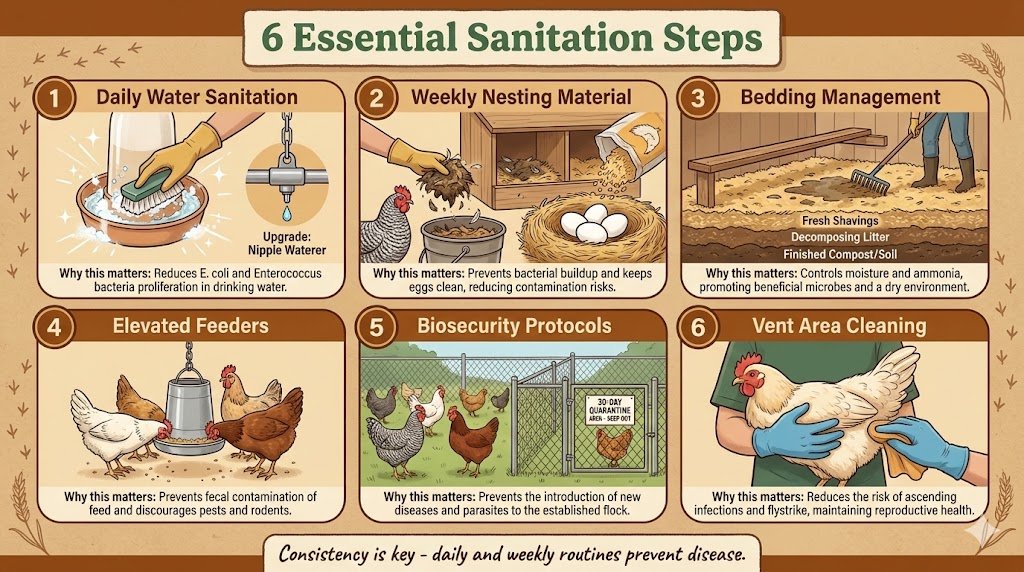
Bacterial infection is the deadly component of egg yolk peritonitis. Since E. coli and Enterococcus migrate from the intestinal tract up through the cloaca into the reproductive tract, reducing bacterial load in the environment is critical.
Step 1: Water Sanitation (Most Critical) The Merck Veterinary Manual highlights drinking water sanitation as one of the best preventive strategies. Consider investing in automatic waterers with sanitizing features or nipple drinkers, which drastically reduce bacterial contamination compared to open founts. Clean waterers daily with a diluted bleach solution (1 tablespoon per gallon of water, rinse thoroughly).
Step 2: Nesting Box Hygiene Replace nesting material weekly or whenever soiled. Hens spend significant time in nest boxes, and bacteria from droppings can contaminate the vent area. Look for nesting box designs that promote hygiene, such as roll-away boxes or those with removable trays for easy cleaning. Use clean pine shavings, straw, or nesting pads.
Step 3: Coop Bedding Management Practice deep litter management or clean coops weekly. Remove wet spots immediately, especially under roosts. Ammonia buildup from dirty bedding stresses respiratory and reproductive systems. Focus on keeping your coop clean and odor-free through proper bedding management to protect their health. Ideally, maintain excellent coop hygiene and natural parasite control.
Step 4: Prevent Fecal Contamination of Feed Use hanging feeders elevated to prevent chickens from scratching bedding and droppings into feed. Store feed in airtight containers to prevent contamination.
Step 5: Biosecurity for Viral Disease Prevention Vaccinate for Marek’s disease if possible (most hatcheries offer this). Quarantine new birds for 30 days before introducing to your flock. Certain viruses like Marek’s disease and Avian Leukosis can damage reproductive tracts, predisposing hens to peritonitis.
Step 6: Regular Vent Cleaning During peak laying season, check hens’ vent areas weekly. Remove dried egg material or droppings that could harbor bacteria near the cloaca opening.
By implementing these sanitation steps consistently, you significantly reduce the bacterial pressure that turns sterile egg yolk peritonitis into a life-threatening infection.
Breed Predispositions
While any chicken can develop egg yolk peritonitis, high-production layer breeds like Leghorns (300+ eggs/year), Rhode Island Reds, ISA Browns, and Golden Comets face higher risk because they’ve been selectively bred for intensive egg laying. Their reproductive systems work overtime compared to heritage breeds or broiler breeds.
Heritage breeds like Brahmas, Cochins, Wyandottes, and Orpingtons typically lay 150-200 eggs per year and experience lower rates of reproductive disorders, though they are not immune. If you’re selecting chickens for a backyard flock and longevity is a priority, consider heritage breeds with more moderate laying patterns that put less strain on reproductive organs. When selecting chickens for your backyard flock, consider breeds with moderate laying patterns that put less strain on reproductive organs.
Poultry management guidelines from Hobby Farms suggest some of the best ways to prevent hens from developing reproductive tumors and peritonitis include feeding proper layer ration and avoiding artificial light. Research from Merck Veterinary Manual emphasizes that management of body weight and uniformity is a top preventive strategy.
Is Egg Peritonitis Contagious? (Common Myths and Facts)
No, egg yolk peritonitis is not contagious. You cannot “catch” it from a hen, and she cannot give it to her flock mates.
However, if you see multiple hens getting sick, you might have a contagious underlying issue.
- A viral infection sweeping the flock (like Bronchitis) can damage oviducts.
- Poor management (obesity, dirty water) affects everyone.
BackYard Chickens community experts clarify that egg yolk peritonitis and internal laying are not contagious. My Pet Chicken confirms that while yolk peritonitis itself is not contagious, the underlying issues may be common to your flock.
Can Peritonitis Cause Other Health Issues in Chickens?
Because the abdomen contains vital organs, having free-floating yolk creates a domino effect of health complications.
Sepsis (Blood Infection)
This is the most dangerous complication. Data from VCA Animal Hospitals indicates that bacteria from the coelom can enter the bloodstream, causing sepsis. Sepsis occurs when the immune system releases chemicals to fight infection, but these chemicals trigger widespread inflammation throughout the body. In chickens, sepsis from egg peritonitis causes rapid deterioration – the hen may appear normal in the morning and be found dead by evening. Signs of sepsis include cold feet, blue/purple comb, lethargy, and reluctance to move even when stimulated.
Organ Damage and Failure
The fluid buildup (ascites) in the abdomen creates immense pressure.
- Respiratory Compromise: Chickens lack a diaphragm; they rely on expanding their body cavity to breathe. Fluid prevents air sacs from inflating, leading to suffocation.
- Liver Damage: The liver becomes compressed and may become friable (easily crumbled) or fatty, further complicating recovery.
Adhesions and Chronic Pain
As the yolk material dries or is partially absorbed, it creates sticky bands of tissue called adhesions. These act like internal scar tissue, gluing organs together. The intestines may stick to the oviduct or abdominal wall, causing chronic pain, difficulty defecating, and digestive stasis.
Secondary Infections
The weakened immune system and nutrient-rich yolk environment invite other pathogens. Hens with peritonitis are more susceptible to respiratory infections, mites, and lice because they stop preening and dust bathing effectively.
Frequently Asked Questions About Egg Yolk Peritonitis
1. Can peritonitis heal on its own?
In rare, sterile cases (mild internal laying without bacteria), the body might reabsorb the yolk. However, once infection sets in (true peritonitis), it will not heal without antibiotics. Waiting typically leads to suffering and death.
2. Should I cull a chicken with egg peritonitis?
This is a deeply personal decision. If treatment is unsuccessful or not financially feasible, and your hen shows signs of suffering – such as inability to breathe comfortably, complete refusal to eat or drink, or inability to stand – humane euthanasia may be the most compassionate option. This should be performed by a licensed veterinarian who can ensure a painless passing. This is not failure on your part as a chicken keeper; it’s an act of mercy.
3. Can I eat eggs from a hen with peritonitis?
In the unlikely event she lays an egg while sick, do not eat it if she is on antibiotics (follow withdrawal times). If she has received a hormone implant (Suprelorin), her eggs are never safe for human consumption again.
4. Is egg yolk peritonitis painful?
Yes. The inflammation of the abdominal lining is painful, and the pressure on organs causes significant discomfort. The “penguin stance” is a posture adopted specifically to relieve pain and pressure.
5. What is the difference between egg binding and egg peritonitis?
Egg binding is an acute emergency where a hard egg is physically stuck near the vent; it kills in hours. Egg peritonitis is a chronic condition where yolk leaks internally; it kills over days or weeks.
6. Does draining the fluid cure the chicken?
Usually, no. Draining fluid (abdominocentesis) provides temporary relief effectively allowing her to breathe better, but the fluid will return unless the underlying infection and ovulation are stopped.
7. Can I prevent this condition 100%?
No. Even with perfect care, high-production breeds (like Leghorns or ISA Browns) are genetically prone to reproductive failure as they age.
8. Is the surgery worth it?
Surgery (salpingohysterectomy) is the only potential “cure” but carries high risk. For a beloved pet, it may be worth it, but for a production bird, the cost ($500-$1,500+) usually outweighs the benefit.
9. Why is my hen’s comb still red if she’s sick?
A red comb indicates reproductive hormones are still active. It can be misleading, making you think she is healthy when she is actually critically ill.
When to Call Your Veterinarian (Action Steps)
Time is critical. If you notice these signs, do not wait and see.
Finding a Veterinarian
Finding an avian veterinarian in your area is crucial before an emergency strikes. Use the Association of Avian Veterinarians directory or search for “exotic pet veterinarian near me,” as many exotic vets treat chickens even if general small animal clinics do not. Learn more about recognizing emergency symptoms in our guide to when to call the vet for backyard chickens.
Emergency Red Flags
Call a veterinarian immediately if your hen displays any of these four critical symptoms:
- Open-mouth breathing – indicates she is drowning in internal fluid
- Cyanosis – comb or wattles turn purple/blue from oxygen deprivation
- Collapse – inability to stand or wings held out for balance
- Flystrike – maggot infestation in dirty vent area (develops within hours)
Emergency Stabilization Protocol (Before Transport)
If you cannot get to a vet immediately:
- Isolate & Warm: Move her to a “Hospital Cage” (dog crate) indoors. Keep the temperature around 75-80°F. Sick birds cannot regulate body heat.
- Hydrate: Electrolytes are crucial. If she isn’t drinking, gently dip her beak in water with electrolytes or a vitamin supplement.
- Minimize Handling: Her belly is painful and full of fluid. Squeezing it can rupture air sacs or cause the fluid to compress her heart. Lift her gently with support under the keel, not the abdomen.
What to Ask Your Vet
When you arrive, be prepared to ask:
- “Can we do a fecal float to rule out parasites?”
- “Is she stable enough for fluid drainage?”
- “What is the cost estimate for bloodwork vs. empirical antibiotic treatment?”
Key Takeaways: Egg Yolk Peritonitis in Backyard Chickens
- ✓ Egg yolk peritonitis occurs when yolk enters the abdomen instead of the oviduct
- ✓ Classic signs: penguin stance, swollen belly, stopped laying, labored breathing
- ✓ Most common bacteria: E. coli and Enterococcus
- ✓ Treatment requires veterinary care – antibiotics, hormone therapy, supportive care
- ✓ Some hens survive with early treatment; others do not despite intervention
- ✓ Prevention focuses on proper weight, avoiding forced laying, and excellent sanitation
- ✓ Not contagious, but multiple cases suggest flock-wide management issues
Conclusion
Egg yolk peritonitis is one of the most challenging reproductive disorders facing backyard chicken owners, but understanding the symptoms, treatment options, and prevention strategies empowers you to give your hens the best possible care. While not every case is survivable, early detection and prompt veterinary intervention can make the difference.
Focus on prevention through proper nutrition, avoiding forced egg production, and maintaining excellent flock sanitation. Most importantly, establish a relationship with an avian veterinarian before emergencies arise. By staying vigilant and informed regarding egg yolk peritonitis treatment, you are already taking important steps to protect your flock’s health.

Oladepo Babatunde is the founder of ChickenStarter.com. He is a backyard chicken keeper and educator who specializes in helping beginners raise healthy flocks, particularly in warm climates. His expertise comes from years of hands-on experience building coops, treating common chicken ailments, and solving flock management issues. His own happy hens are a testament to his methods, laying 25-30 eggs weekly.
